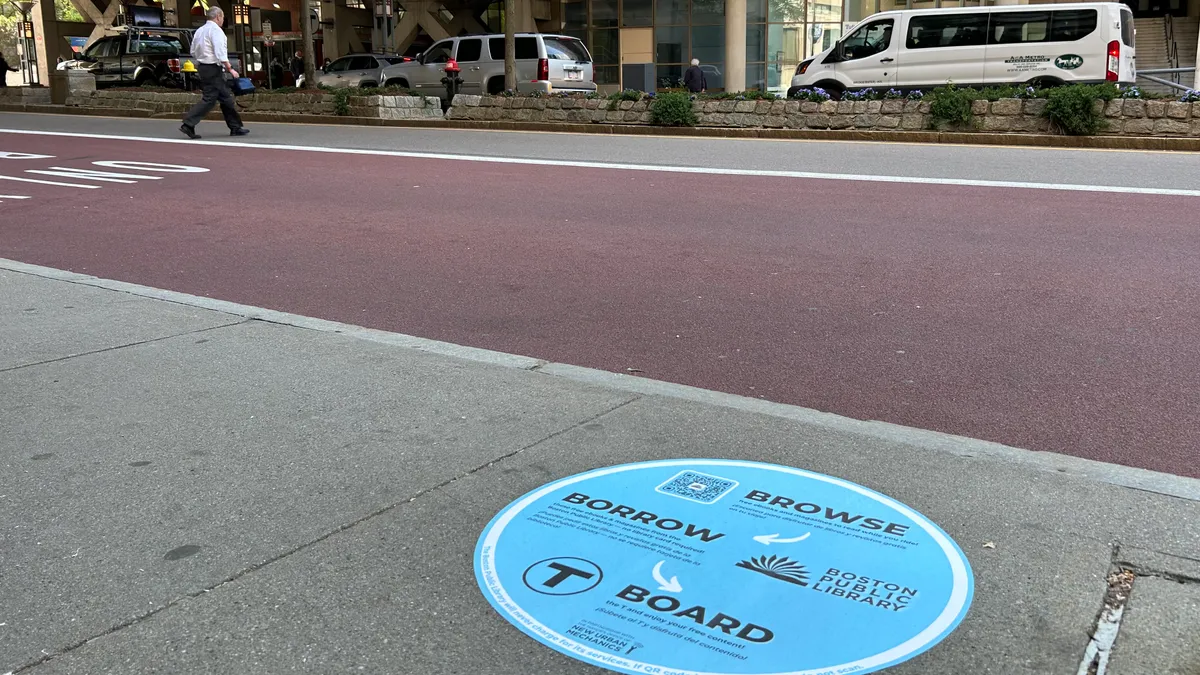Dive Brief:
- Twenty bus stops across Boston were outfitted last week with quick response, or QR, codes allowing riders to browse and borrow audiobooks, e-books, e-newspapers and e-magazines from the Boston Public Library, Boston Mayor Michelle Wu announced Thursday.
- Users are not required to have a library card or download an app to access the primarily English- and Spanish-language offerings, as the primary goal of the “Browse, Borrow, Board” program is to introduce riders to the library’s resources, the announcement says.
- The pilot — which will run through August — shows the value of simple partnerships between large bureaucracies such as libraries, transportation authorities and cities, said Maddie Webster, program manager in the Mayor’s Office of New Urban Mechanics, which helped develop the initiative.
Dive Insight:
The pilot program is based on a transit rider survey conducted last year by MONUM summer fellow Bailey Siber amid discussions between leaders at the BPL and the Massachusetts Bay Transportation Authority about a potential collaboration, Webster said.
Through an in-person and online survey, Siber collected more than 250 constituent responses in numerous languages to understand what kinds of resources people wanted to see from the BPL, which services they’d like that BPL doesn’t offer and what they’d like to do on a bus.
About three-quarters of respondents said access to BPL resources would likely or very likely make their public transit experiences more enjoyable, Webster said. “Bus riders, in particular, were a demographic that was really interested in these services, potentially because the buses don't come as frequently,” she said. “Also, the bus lines serve some of our underserved communities that may not already know about the services that the BPL offers.”
The 20 bus stops included in the pilot are scattered across “pretty much every neighborhood,” Webster said. She selected the stops by analyzing MBTA data to see which had the most boardings, finding high numbers at those serving the three fare-free bus routes established in early 2022. In neighborhoods where it wasn’t clear which bus stop was most popular, she contacted liaisons in the neighborhood services office to determine which stop “seems to be more happening than the rest.”
MONUM placed the large, slip-resistant, sky-blue QR code decals on the ground to more effectively catch people’s attention since there’s already a lot of signage at eye level, Webster said.
The “number one metric” for the pilot’s success will be how many users sign up for a library card, she said, although MONUM is also interested in surveying users on whether the service made their public transit experiences “more delightful.”
The BPL deliberately included materials in the digital library that are easy to browse “on the go,” such as poetry, short stories, newspapers, magazines and short audiobooks, Thursday’s announcement says. More offerings will be added throughout the summer, with users allowed to check out up to five titles at once for two weeks, after which they can scan the QR code again to re-register and check out more.
Already, MONUM is considering other creative ways to leverage bus stops, including as “points of climate resilience,” Webster said. For example, bus stops can be places for people to weather extreme heat.
“They’ve looked at water fountains connected to bus stops, types of [air conditioning] that can be connected to bus stops that is also environmentally friendly, WiFi connected to bus stops, all different kinds of things,” she said. “They’re places where people gather and often have to wait a while and are often not necessarily next to a bunch of shady trees in a park because they’re in the public right-of-way.”











